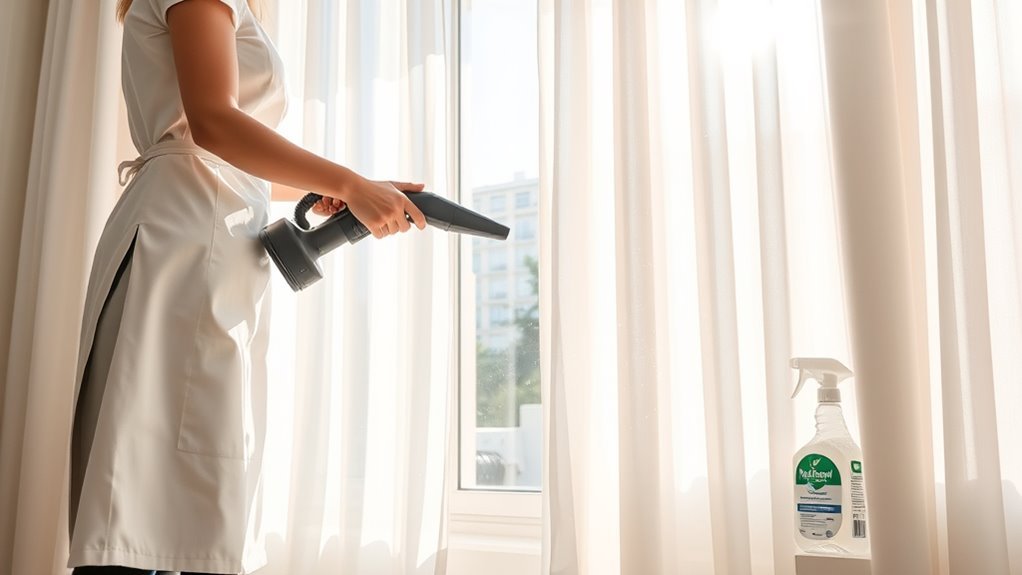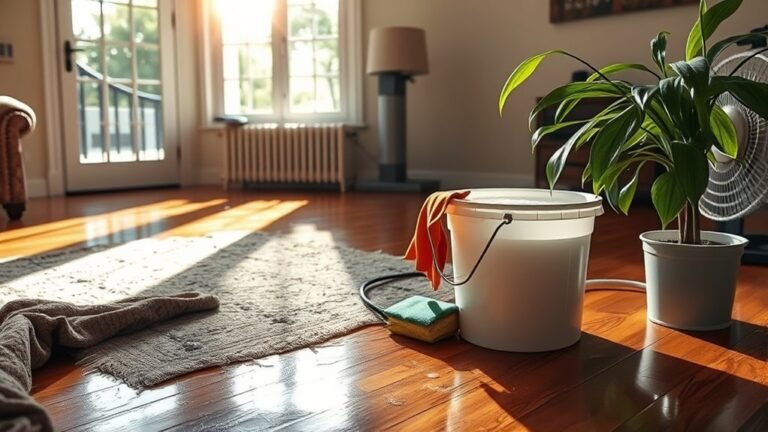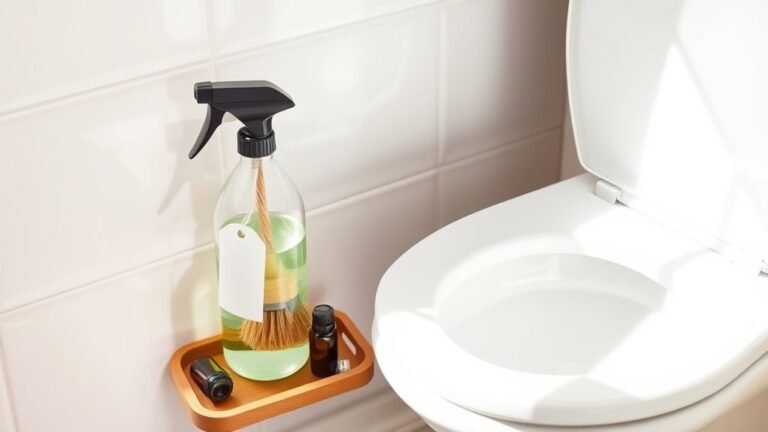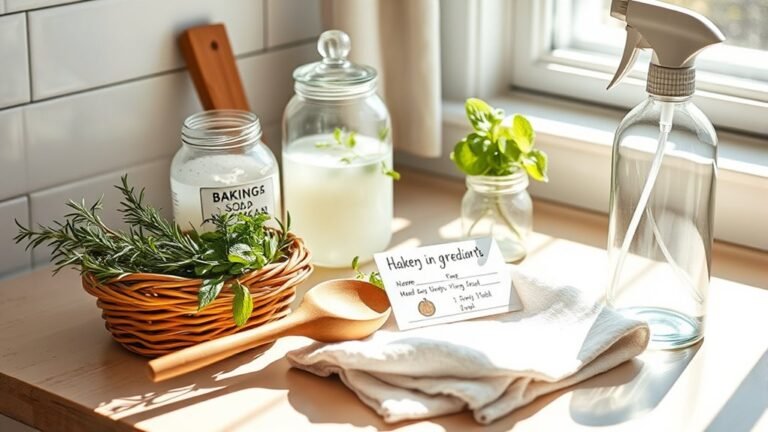How to Remove Germs From Curtains
To remove germs from your curtains, first check the fabric type to choose the right cleaning method. Vacuum regularly with a soft brush to get rid of dust and allergens. You can gently spray a natural disinfectant like diluted vinegar with essential oils, then let them air dry. For deeper cleaning, machine wash on a gentle cycle or hand wash using mild detergent, depending on the label. Keep up routine maintenance to prevent germ build-up—there’s more helpful advice to explore.
Identifying Fabric Types and Cleaning Requirements

Before you begin cleaning your curtains, it’s important to identify the fabric type since different materials require specific care methods. Fabric identification helps you choose the right cleaning solutions, ensuring your curtains stay fresh without damage. Natural fabrics like cotton or linen can often handle gentle washing, while delicate silks or velvets need specialized treatments. Synthetic materials might tolerate stronger solutions but check labels to avoid shrinking or color fading. Knowing your curtain’s fabric lets you pick effective, safe cleaning methods, freeing you from worries about ruining them. Take a moment to read tags or test a small hidden area with your chosen cleaning solution. This simple step guarantees your curtains get cleaned thoroughly while preserving their texture and appearance.
Regular Vacuuming and Dusting Techniques
Regularly vacuuming and dusting your curtains is key to preventing dirt and allergens from building up. To keep your curtains fresh and germ-free, mastering vacuum attachment techniques and choosing the right dusting tools makes all the difference. Here’s how you can take control:
Master vacuum techniques and choose the right dusting tools to keep curtains fresh and allergen-free.
- Use a soft brush vacuum attachment to gently remove dust without damaging fabric.
- Work from top to bottom to avoid redistributing dirt.
- Employ microfiber dusting tools for a quick, effective swipe between deeper cleans.
- Schedule vacuuming every one to two weeks for continuous freshness.
Using Natural Disinfectants for Safe Sanitizing

While synthetic cleaners can be effective, you might prefer using natural disinfectants to sanitize your curtains safely. Vinegar solutions are a great choice—they’re easy to make by mixing equal parts water and white vinegar. This combo helps kill germs without harsh chemicals. To boost the scent and disinfectant power, add a few drops of essential oils like tea tree or lavender. These oils have natural antimicrobial properties and leave your curtains smelling fresh.
You can apply this solution with a spray bottle, lightly misting your curtains without soaking them. Let them air dry completely to guarantee the disinfectant works effectively. Using natural disinfectants gives you control over what touches your fabric, keeping your space clean and free from unwanted toxins.
Washing Curtains: Machine and Hand Wash Methods
If you want to thoroughly remove germs and dirt from your curtains, washing them by machine or hand is often your best bet. Before you get started, always check the care label to guarantee fabric safety and prevent damage. Whether you choose machine or hand wash, keep curtain care in mind to maintain their look and feel.
Here’s how to handle it:
- Use a gentle cycle with cold water in the machine to protect delicate fabrics.
- Opt for mild detergent to avoid harsh chemicals that can degrade fibers.
- For hand washing, soak curtains in lukewarm water and gently agitate without wringing.
- Air dry your curtains flat or hang them to keep their shape intact and avoid shrinkage.
This way, you keep your curtains fresh and germ-free without compromising their quality.
Preventing Germ Build-Up With Routine Maintenance

Washing your curtains thoroughly helps remove existing germs, but keeping them fresh over time means adopting a routine maintenance plan. By setting up a maintenance schedule, you can take simple preventive measures that stop germs from settling and multiplying. Regularly vacuuming your curtains with a brush attachment removes dust and airborne particles that harbor bacteria. Don’t forget to air them out often—fresh air naturally reduces moisture and odors where germs thrive. Spot-clean stains immediately to prevent deeper contamination. You might also consider using fabric sprays with antimicrobial properties as a quick refresher. Sticking to these habits lets you enjoy clean curtains without hassle, giving you the freedom to focus on what matters while keeping your space healthy and inviting. Consistency is key to preventing germ build-up efficiently.
Frequently Asked Questions
Can Steam Cleaning Curtains Kill All Types of Germs?
You want to know if steam cleaning can kill all germ types, right? While steam cleaning is great for wiping out many bacteria, viruses, and fungi, it doesn’t guarantee elimination of every single germ type. Some germs hide in fabric folds or deeper fibers where steam may not reach fully. So, you can rely on steam cleaning for a powerful cleanse, but combining methods gives you the freedom to feel truly germ-free.
How Often Should Curtains Be Professionally Cleaned for Germ Removal?
When deciding on curtain cleaning frequency, you’ll want to take into account your environment and lifestyle. Professional cleaning recommendations typically suggest every 6 to 12 months to keep germs at bay, especially if you have pets or allergies. If you crave freedom from constant chores, sticking to this schedule helps maintain fresh, germ-free curtains without much effort. Ultimately, regular professional cleaning keeps your space healthier and lets you enjoy your freedom worry-free.
Are Antimicrobial Sprays Safe for All Curtain Fabrics?
Think of antimicrobial sprays like a double-edged sword—they can protect your curtains but might also damage certain fabrics. You’ll want to check the label carefully because not all curtain materials react the same way; some delicate fabrics might lose color or texture. While these sprays boost antimicrobial effectiveness, freedom means choosing what suits you best. Test a small area first, so you’re confident your curtains stay safe and fresh without unwanted surprises.
Can UV Light Be Used to Disinfect Curtains Effectively?
You might be wondering if UV technology can help disinfect your curtains. UV effectiveness depends on exposure time and intensity, so while it can reduce germs, it may not fully sanitize thick fabrics or hidden areas. Plus, prolonged UV exposure could fade or damage some materials. If you’re seeking freedom from harsh chemicals, UV light is a neat option, but combining it with regular washing keeps your curtains truly fresh and germ-free.
Do Curtains Collect More Germs Than Other Household Fabrics?
You might be surprised, but curtains can collect more germs than some other household fabrics. It really depends on the curtain materials—natural fibers like cotton can hold moisture, making them germ hotspots. Since curtains aren’t washed as often as clothes or bedding, germs can build up over time. So, if you want to feel free from hidden bacteria, it’s smart to clean your curtains regularly and choose materials that resist germ buildup.






